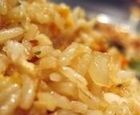|
Mid-East Side Rice Pilaf This pilaf calls for browning the rice first with onions and pine nuts until it yields up its nutty fragrance. Then bake it in broth.
Preheat oven to 375. Bring stock to a boil in a saucepan. In the meantime, heat oil in a large skillet over medium heat. Add onion and sauté 5-7 minutes, till translucent. Add rice, cooking and stirring for 10 more minutes until rice becomes translucent. Add salt & pepper and toasted nuts. Transfer rice to a casserole.* Add boiling stock and cover quickly and tightly with foil. Bake for 35-40 minutes, till rice grains are fluffy and liquid has evaporated. Sprinkle with chopped parsley and serve immediately. Serve with Shish Kabobs. * If your saute skillet is oven proof, with a lid, use that. Then you won’t have to transfer the rice to a casserole and lose heat. |
Tips & Glossary Many of the ingredients used for Middle-Eastern cooking may not be in your spice shelf, but you can find them at Mid-Eastern food stores. So to avoid frustration, make a list of the items you need before trying out the recipes. Toss any old, even unopened, spice jars because they’ve probably lost their distinctive flavors. Put them on your shopping list. Bulgur Wheat: wheat grains that have been par-boiled, dried, and de-branned. Bulgur has a high fiber content and wonderfully nutty flavor. Cardamom: related to ginger. Pods (green, brown, or black) are the best way to store the spice, although high-quality ground is readily available. A equivalency: 10 pods = 1½ tsp. ground cardamom. Coriander: aka cilantro, Chinese, or Mexican parsley. Fresh leaves and dried ground seeds are used in Mid-East, Asian, Indian, and Mexican cuisines. Cumin: related to parsley and carrot plant; an important ingredient in chili powder. Used especially in curries, but also in Mid-Eastern, Mexican and Asian dishes. Cumom has an earthy, peppery flavor. Deep Frying: oil must be hot enough; otherwise food will be soggy and greasy. Use a deep-fry thermometer to ensure proper temperature is reached. When cool, oil can be strained, refrigerated, and re-used. Filo: aka phyllo; paper-thin sheets of raw, unleavened flour dough. Purchase frozen in any grocery store and follow directions on package for thawing. When working with one sheet, keep others covered with a damp towel to prevent drying out. Rosewater: distilled from rose petals and used to flavor Mid-Eastern and Asian cooking. You can make your own—but why? Purchase it at Asian or Middle Eastern food stores. Semolina flour: made from hardy durum wheat. A yellowish flour, it's used in Asian and Mid-East cooking (couscous). In the U.S., it's Farina, a breakfast cereal. Tahini: paste from ground, hulled sesame seeds. A major ingredient in hummus and other Mid-Eastern and Asian foods, you can purchase at most grocery stores.
|
Site by BOOM
![]()
LitLovers © 2024

